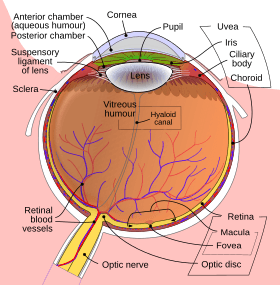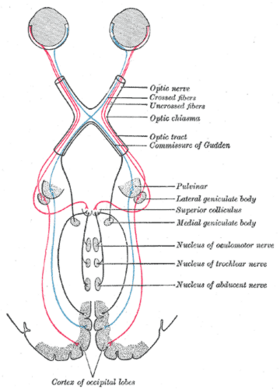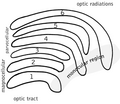Visual system facts for kids
The visual system is the part of the nervous system which allows organisms to see. It interprets the information from visible light to build a representation of the world surrounding the body. The visual system has the complex task of (re)constructing a three dimensional world from a two dimensional projection of that world. The psychological manifestation of visual information is known as visual perception.
Introduction
This article mostly describes the visual system of mammals, although other "higher" animals have similar visual systems. In this case, the visual system consists of:
- The eye, especially the retina
- The optic nerve
- The optic chiasma
- The optic tract
- The lateral geniculate nucleus
- The optic tectum (superior colliculus)
- The optic radiation
- The visual cortex
- The visual association cortex
Different species are able to see different parts of the light spectrum; for example, bees can see into the ultraviolet, while pit vipers can accurately target prey with their infrared imaging sensors.
- David H. Hubel 1989. Eye, Brain and Vision. New York: Scientific American Library.
- David Marr 1982. Vision: A Computational Investigation into the Human Representation and Processing of Visual Information. San Francisco: Freeman.
- R.W. Rodiek 1988. The Primate Retina. In Comparative Primate Biology. vol 4 of Neurosciences. eds H.D. Steklis and J. Erwin. pp. 203–278. New York: A.R. Liss.
- Martin J. Tovée 1996. An introduction to the visual system. Cambridge University Press. ISBN: 0-521-48339-5
- Andreas Vesalius 1543. De Humani Corporis Fabrica (On the Workings of the Human Body)
- Torsten Wiesel and David H. Hubel 1963. The effects of visual deprivation on the morphology and physiology of cell's lateral geniculate body. Journal of Neurophysiology 26, 978-993.
Images for kids
-
S. Ramón y Cajal, Structure of the Mammalian Retina, 1900
-
Visual cortex: V1; V2; V3; V4; V5 (also called MT)
See also
 In Spanish: Sistema visual para niños
In Spanish: Sistema visual para niños








